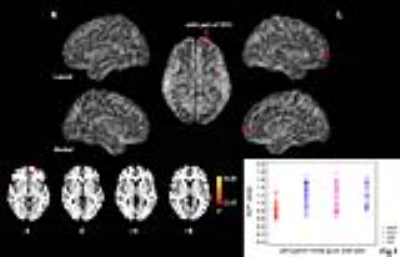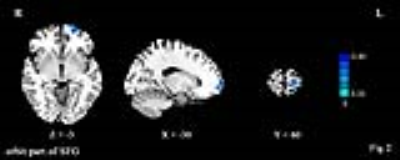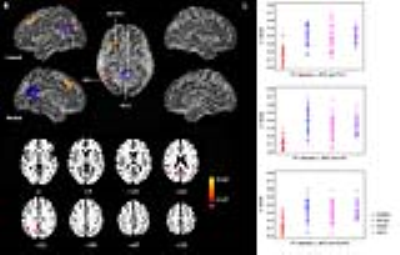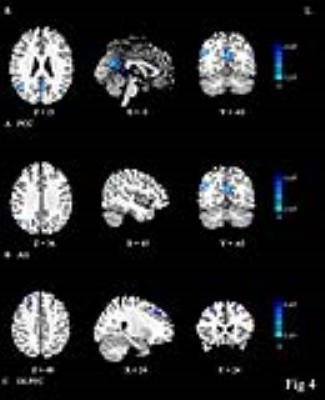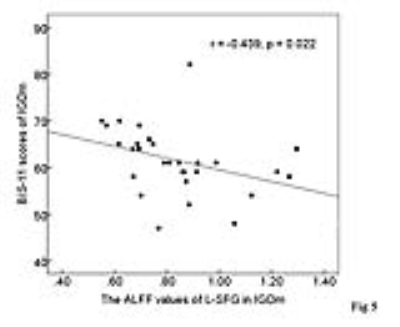2300
Sex differences in resting-state cerebral activity alterations in Internet gaming disorder1Department of Radiology, Ren Ji Hospital, School of Medicine, Shanghai Jiao Tong University, Shanghai, China, 2Ge Applied Science Laboratory, GE Healthcare, Shanghai, China
Synopsis
The purpose of this study was to explore the sex-specific neuroimaging differences involved in IGD. Thirty IGDm, 23 IGDf, 30 HCm and 22 HCf underwent rs-fMRI. ALFF and seed-based FC maps were constructed. A two-factor ANCOVA model was specified using SPM8, with sex and diagnosis as the between-subject factors. When interaction effects occurred, post-hoc pair-wise comparisons were performed using two-sample t-tests within the interaction masks. IGDm and IGDf exhibited different regional and network-level functional changes. Lower ALFF values in the orbit part of SFG showed higher impulsivity in IGDm. The results may lead to improved sex-specific treatment and prevention strategies .
INTRODUCTION
Although evidence shows that the prevalence rates of Internet gaming disorder (IGD) differ between males and females,1 no studies have examined whether such sex differences extend to brain function. This study was to explore the sex differences in resting-state cerebral activity alteration in IGD.METHODS
Thirty male participants with IGD (IGDm), 23 female participants with IGD (IGDf), and 30 male and 22 female age-matched healthy controls (HC) were recruited and underwent resting-state functional MR imaging. Maps of amplitude of low-frequency fluctuation (ALFF) and seed-based functional connectivity (FC) were constructed. A two-factor ANCOVA model was specified using SPM8, with sex (male, female) and diagnosis (IGD, HC) as the between-subject factors. When interaction effects occurred, post-hoc pair-wise comparisons were performed using two-sample t-tests within the interaction masks. We used the Barratt impulsiveness scale-11 (BIS-11) to assess the behavioral inhibition function and the Chen Internet Addiction Scale (CIAS) to evaluate the severity of IGD. The correlations of psychological scores with ALFF and FC values were assessed using partial correlation analysis, respectively.RESULTS
The ALFF values in the orbit part of left superior frontal gyrus (SFG) significantly decreased selectively in IGDm, which was negatively correlated with BIS-11 score. Furthermore, IGDm also showed decreased connectivity between the orbit part of left SFG and posterior cingulate cortex (PCC), right angular gyrus (AG), and right dorsolateral prefrontal cortex (DLPFC).DISCUSSION
Deficits in impulse inhibition are related to IGD2, which is more prevalent in males than in females. Understanding the sex differences in brain activity and the relationship with impulse inhibition may help elucidate the neurobiological basis of IGD.
In this study, the BIS-11 correlates of regional neural functional alterations demonstrated that the impairment in SFG may have an impact on impulsive behavior selectively in IGDm. This finding is partly consistent with some previous studies of substance addiction. Alcohol use is correlated with impulsivity in both males and females; this correlation is stronger in males3. Another study demonstrated that male methamphetamine users had larger right SFG with greater impulsivity4. Some researches demonstrated that the brain changes vary differentially by sex in substance addiction, suggesting either differential neurotoxic sensitivities for males and females or sexual dimorphic endophenotypic risk factors5. However, no chemical or substance intake is involved in IGD. One possible explanation of the sex differences in prefrontal cortex may be related to the greater susceptibility to changes during the pathological Internet use. It is plausible that, compared to females, males are more susceptible to the effects of long-time online-game playing and exhibited impaired prefrontal functioning and greater impulsivity.
IGDm also showed alterations in network-level brain function. PCC, AG, and DLPFC have a close correlation with IGD as well. Importantly, PCC, AC, and DLPFC are core nodes with the default mode network (DMN). The DMN is hypothesized to contribute to internal mentation associated with self-referential mental activity and emotional processing tasks6, and it may also serve important cognitive functions7. Recent studies have shown that IGD is accompanied with altered activity patterns of the DMN8. Our findings indicate that the IGD brain may exhibit an imbalance in altered FC within the DMN, and this is particularly pronounced in IGDm.
CONCLUSION
Our findings suggest that sex-specific regional- and network-level alterations existed in IGD, and the altered ALFF in SFG has clinical relevance as a biomarker for the behavioral inhibition function of IGDm. Future research may consider the possible implications of sex-specific treatment and prevention strategies for IGD.Acknowledgements
This work was supported by the National Natural Science Foundation of China (No. 81571650), Shanghai Municipal Education Commission-Gaofeng Clinical Medicine Grant Support (No. 20172013), Shanghai Science and Technology Committee Medical Guide Project (No. 17411964300).References
1. Shek DT, Yu L. Adolescent Internet Addiction in Hong Kong: Prevalence, Change, and Correlates. J Pediatr Adolesc Gynecol. 2016;29:S22-30.
2. Argyriou E, Davison CB, Lee TTC. Response Inhibition and Internet Gaming Disorder: A Meta-analysis. Addict Behav. 2017;71:54-60.
3. Stoltenberg SF, Batien BD, Birgenheir DG. Does gender moderate associations among impulsivity and health-risk behaviors? Addict Behav. 2008;33:252-265.
4. Kogachi S, Chang L, Alicata D, et al. Sex differences in impulsivity and brain morphometry in methamphetamine users. Brain Struct Funct. 2017;222:215-227.
5. Kvamme TL, Schmidt C, Strelchuk D, et al. Sexually dimorphic brain volume interaction in college-aged binge drinkers. Neuroimage Clin. 2016;10:310-317.
6. Buckner RL, Andrews-Hanna JR, Schacter DL. The brain's default network: anatomy, function, and relevance to disease. Ann N Y Acad Sci. 2008;1124:1-38.
7. Broyd SJ, Demanuele C, Debener S, et al. Default-mode brain dysfunction in mental disorders: a systematic review. Neurosci Biobehav Rev. 2009;33:279-296.
8. Dong G, Li H, Wang L, et al. The correlation between mood states and functional connectivity within the default mode network can differentiate Internet gaming disorder from healthy controls. Prog Neuropsychopharmacol Biol Psychiatry. 2017;77:185-193.
Figures
